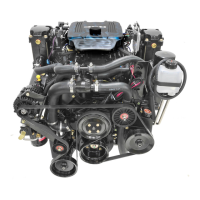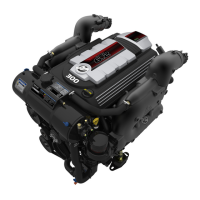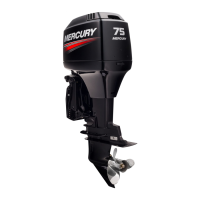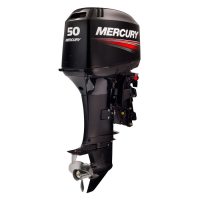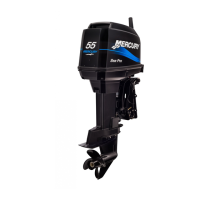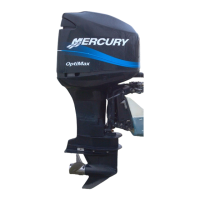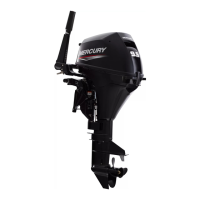GENERAL INFORMATION
90-857138R1 MAY 2000 Page 1C-3
Summer Conditions of high temperature, low barometric pressure and high humidity all
combine to reduce the engine power. This, in turn, is reflected in decreased boat speeds--as
much as 2 or 3 miles-per-hour (3 or 5 Km per-hour) in some cases. (Refer to previous chart.)
Nothing will regain this speed for the boater, but the coming of cool, dry weather.
In pointing out the practical consequences of weather effects, an engine--running on a hot,
humid summer day--may encounter a loss of as much as 14% of the horsepower it would
produce on a dry, brisk spring or fall day. The horsepower, that any internal combustion en-
gine produces, depends upon the density of the air that it consumes and, in turn, this density
is dependent upon the temperature of the air, its barometric pressure and water vapor (or
humidity) content.
Accompanying this weather-inspired loss of power is a second but more subtle loss. At rig-
ging time in early spring, the engine was equipped with a propeller that allowed the engine
to turn within its recommended rpm range at full throttle. With the coming of the summer
weather and the consequent drop in available horsepower, this propeller will, in effect, be-
come too large. Consequently, the engine operates at less than its recommended rpm.
Due to the horsepower/rpm characteristics of an engine, this will result in further loss of
horsepower at the propeller with another decrease in boat speed. This secondary loss, how-
ever, can be regained by switching to a smaller pitch propeller that allows the engine to again
run at recommended rpm.
For boaters to realize optimum engine performance under changing weather conditions, it
is essential that the engine have the proper propeller to allow it to operate at or near the top
end of the recommended maximum rpm range at wide-open-throttle with a normal boat
load.
Not only does this allow the engine to develop full power, but equally important is the fact
that the engine also will be operating in an rpm range that discourages damaging detona-
tion. This, of course, enhances overall reliability and durability of the engine.
Boat
WEIGHT DISTRIBUTION
1. Proper positioning of the weight inside the boat (persons and gear) has a significant ef-
fect on the boat’s performance, for example:
a. Shifting weight to the rear (stern).
(1.)Generally increases top speed.
(2.)If in excess, can cause the boat to porpoise.
(3.)Can make the bow bounce excessively in choppy water.
(4.)Will increase the danger of the following - wave splashing into the boat when
coming off plane.
b. Shifting weight to the front (bow).
c. Adjusting tilt pin to achieve best performance and handling.
(1.)Improves ease of planing off.
(2.)Generally improves rough water ride.
(3.)If excessive, can make the boat veer left and right (bow steer).
BOTTOM
For maximum speed, a boat bottom should be nearly a flat plane where it contacts the water
and particularly straight and smooth in fore-and-aft direction.

